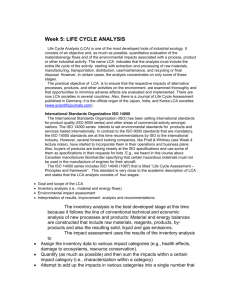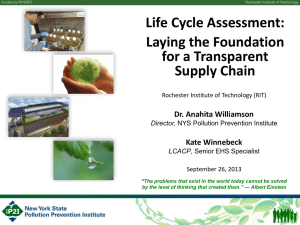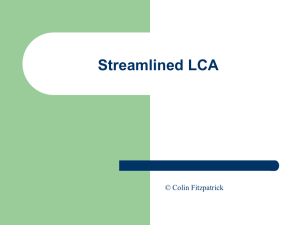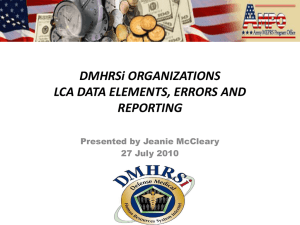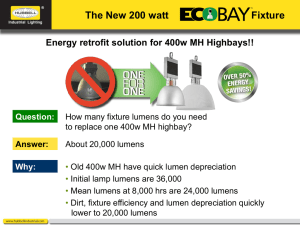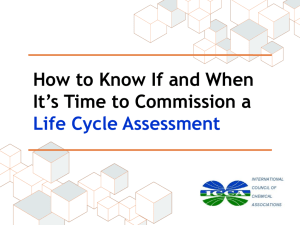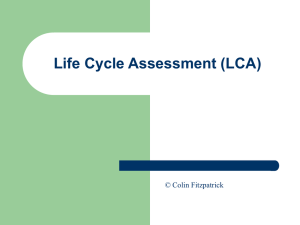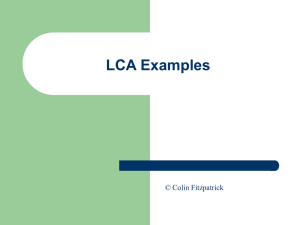Plumbing Product LCA Review and Approach
advertisement
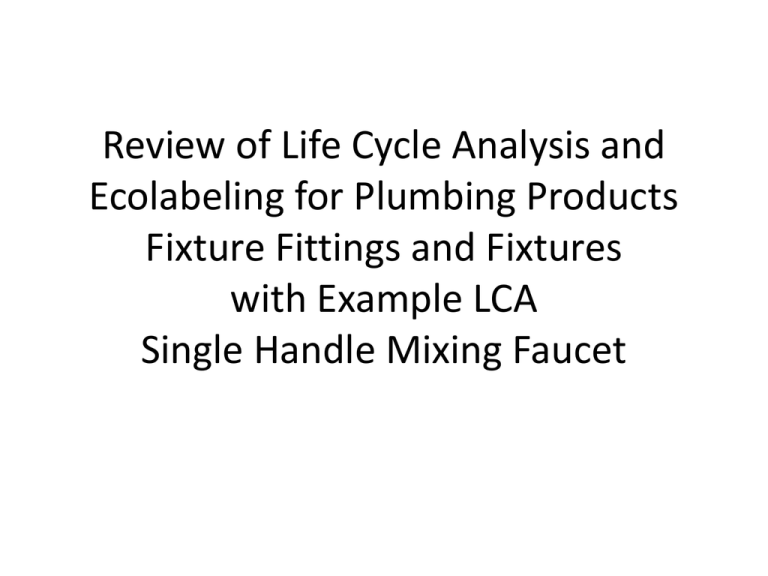
Review of Life Cycle Analysis and Ecolabeling for Plumbing Products Fixture Fittings and Fixtures with Example LCA Single Handle Mixing Faucet PMI – LCA Discussion • Within this PowerPoint slide set are the following: – Quick overview of ISO 14024 and 14025, Type I and Type III Standards for Environmental Product Declarations (supported by ISO 14040 Series LCA Standards) – Discussion of potential PMI Fixture Fitting and possible Fixture Environmental Product Declaration Standards approaches – Short Overview of the European Ecotapware (fixture fittings as faucets and showers) and Ecosanitaryware approaches – An LCA example of a single handle Lavatory Faucet using Sustainable Minds internet based software – A summary of the Business and Institutional Furniture Manufacturers Association (BIFMA) ISO 14025 based draft standard for Environmental Product Declarations on Seating (NSF Sustainability as the Secretariat) ANSI and LCA’s • ANSI’s accreditation committee is currently working on the process by which they would accredit 3rd party certifiers to conduct Life Cycle Analysis and conduct Environmental Declaration programs. • The basis for the accreditation program will be the ISO 14020 Series covering Environmental Declaration programs and Ecolabeling, and the 14040 Series covering LCA’s ISO 14024 and 14025 14024 • • • • • Scope – Established principles and procedures for developing Type I environmental labeling programs, including selection of product categories, product environmental criteria and product function characteristics; for assessing and demonstrating compliance. Type I environmental labeling program – voluntary, multiple-criteria-based third party program that awards a license which authorizes the use of environmental labels on product indicating overall environmental preferability of a product within a particular product category based on life cycle considerations. Objective – to contribute to a reduction in the environmental impacts associated with products, through the identification of products that meet a specific Type I program’s criteria for overall environmental preferability. Selectivity – Product environmental criteria shall be established to differentiate environmentally preferable products from others in the product category, based on a measureable difference in environmental impact. (Use phase?) Identification of the areas most relevant for reduction of environmental impact – the ecolabeling body shall identify the product life cycle stages where there is differentiation of environmental impacts among products within the category. 14025 • • • • Scope - establishes the principles and procedures for developing Type III environmental declaration programs and Type III environmental declarations. It specifically establishes the use of the ISO 14040 series of standards in the development of Type III programs and environmental declarations Type III environmental declaration – providing quantified environmental data using predetermined parameters and, where relevant, additional environmental information. Objectives – a) o provide LCA-based information and additional information on the environmental aspects of products; b) to assist purchasers and users to make informed comparisons between products – these declarations are not comparative assertions; c) to encourage improvement of environmental performance; d) to provide information for assessing the environmental impacts of product over their life cycle. Life Cycle Basis – in the development of Type III environmental declarations, all relevant environmental aspects of the product through its life cycle shall be taken into consideration. If the aspects considered do not cover all stages of the life cycle then this shall be stated and justified. PMI-US Plumbing Fixture Fitting and Fixture LCA Suggested Approach (1) • Consider a 14024 based voluntary standard – Fixture Fittings (Faucets, Showerheads) • as these products control the rate at which water is dispensed, the use phase energy (carbon footprint), as the example shows, dominates all LCA categories. • Due to the materials used, and particularly as we have virtually eliminated Lead, the Human Health and Ecotoxicity Impact categories in the manufacturing and endof-life phases have minimal impact. In fact, they are 2 orders of magnitude or more less than the carbon footprint. • Future regulations will eliminate the use of certain chemical constituents in materials, lowering the Human Health and Ecotoxicity impacts even further. • As manufacturers find alternatives to banned substances, the remaining alternatives, including the use of recycled materials will have no discernable impact on LCA scores. – Fixture Fittings (Shower Valves) and Fixtures (Toilets) • These two product categories influence water used in total, since to fill a tub or flush a toilet, the Use Phase Impact over their life is based upon gallons per use, rather than flow rate. For the Shower valve , there will be an additional carbon footprint energy factor to heat the water used; while toilets only involve cold water use. However, even for toilets in the use phase over their expected life, we anticipate the energy used will still significantly outweigh the human health and ecotoxicity factors. Manufacturing phase energy for toilets could also be significant as the product is fired to create the vitreous glazed surfaces. PMI-US Plumbing Fixture Fitting and Fixture LCA Suggested Approach (2) • Consider a 14025 based voluntary standard – Fixture Fittings (Supply Stops, Supplies) and Fixtures (Sinks and Bathtubs) • Sinks, Bathtubs, Supplies and Supply Stops, as well as Drainage Fittings just convey water, and do not affect the amount of water used in a direct fashion. • The energy used in the manufacturing phase may be the dominant LCA Impact category, although this deserves further analysis in working up some examples. • Ecolabeling Approach – For the 14024 Fixture Fittings and Fixtures • An Ecolabel may primarily indicate compliance with water conservation flow rate or gallons per use ranges, as Human Health and Ecotoxicity Impacts will be negligible as discussed above. • Work needs to be done to think through what ranges might be represented by a rating scheme. In Europe, A through E ratings are used. Does this make sense in the US? Do we need that many ranges? • What other stakeholders need to be involved in establishing the Ecolabeling Standard and Labeling/Rating Scheme? Ecotapware and Ecosanitaryware Standards (European Drafts) • Ecotapware – Sets Use Phase life at 16 years – Provides baseline estimates of annual total water use and hot/cold proportion. A North American version would require data that reflects usage behavior here. – Only assesses energy to heat the hot water (to 140oF for Legionella – not an issue residentially in the US). – Misses the energy used to pump and treat water (both supply/potable and waste) – Assumes that generally, faucets and showerheads are recycled for metal content. However it does not yet contemplate a formal recycling program to ensure materials are returned. In the US and Canada, a significant proportion of these products are replaced by DIY’ers and a recycling incentive program could be desirable. Ecosanitaryware (Toilets and Urinals) • European Life Set – 12.5 years (domestic) and 17.5 years (Commercial) US NAHB Expected Lifetime is “Unlimited” for Toilets, with 10 year life on Flush and Fill Valve mechanisms. Urinals 22.5 years (all types, single, trough, waterless) • Use Phase Input (Toilets) – – 6 Liters/Flush – 7.75 flushes per day(residential), 25 (commercial) • Total Energy Consumption – Distribution 1X, Use Phase 2X, Manufacturing 4X • Electricity Consumption – Manufacturing Phase ~0.9X, all others (electricity) negligible • A number of other Impact analyses available – http://susproc.jrc.ec.europa.eu/toilets/ Look for Base Case Report under the Documents page Manufacturing Phase - Bill of Materials Based has material and process impacts – note the CO2 total is 11.g kg. General Scorecard by BEES Category Human Health, Toxicity and Warming values largely the effect of electric power for treating and pumping water in the Use Phase Use – Water Heating Use - Water Pumping/treatment Note that Energy impacts of Use Phase dominate carbon footprint by orders of magnitude! US assumption – ½ of components shipped inbound by truck average of 200 miles US assumption – ½ of components shipped inbound from China by ship (used 8000 miles, divided by 2 since only ½ of parts sourced overseas) Outbound – in US, just picked a 600 mile average by truck • Note energy to pump and treat covers both potable water supply component and waste water (sewage) treatment • For the hot water component (55% of total) the energy to raise water from 40 to 126oF is 40x more than the pumping/treating energy. Because only 55% of the water is heated, the CO2 values are on the order of 20x in this example Use phase (total impacts) = 2x Manufacturing Use Phase = 1,735,000 x Transportation Energy (Carbon) in Use Phase is 104x the manufacturing phase energy Use Phase is 660x transportation energy Manufacturing energy is 6.3x transportation BIFMA (Business and Institutional Furniture Manufactures Association) Product Category Rules – Seating (draft) • Draft rules/approach to Seating LCA, with Environmental Product Declaration rules for ISO compliant 3rd party verification • Program Operator – NSF, International (National Center for Sustainability Standards) • ISO 14025 compliant EPD standard • Specifically declares: – “ The purpose of the PCR is to provide guidance for creating Type III Labels and is not intended for comparative studies of different products.” – “The goal and scope statement shall not be of a comparative nature. This is because the results are not meant as a platform for comparability to other companies and/or products. Even for similar products, differences in functional unit, use and end-of-life stage assumptions, and data quality may produce incomparable results. • The document outlines in great detail the functional unit (10 year life, not mandatory however), System Boundaries, Boundary Conditions for each phase, Standardized transport distances, Production, Distribution, Storage and Use Rules, End-of-Life, LCIA methodology, Allocation Rules, and much more. • http://bifma.org Under Standards page: https://bifma.org/secure/orderform.html Next Steps • Do we agree on an approach? • Present the analysis to the IAPMO GTC and IgCC groups to get their stakeholder input • Take a look at CB’s who might assist in pulling together the stakeholders in creating an ISO 14024 or 14025 EPD standard for our category(ies). • Have PMI members run some internal analyses and think over a 2-3 tier label rating scheme (what should it mean and what are appropriate levels?) • As to Levels, the balance is to provide some basic differentiation, but not lead us into ever lower flow rates/water consumption below that which provides the needed utility for the product users. What should we do to continue to research and gather user satisfaction feed back on the minimum utility question? Do we continue to explore this with WaterSense?

